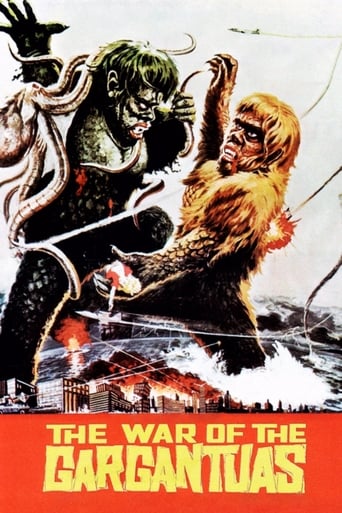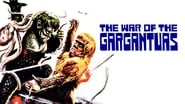ferbs54
Up until last week, I was probably the only baby-boomer fan of Japanese monster movies ("kaiju-eiga," I believe they're called) who had never seen the 1966 Ishiro Honda cult favorite "The War of the Gargantuas." Though the film had been lauded by numerous friends and coworkers, and though I have read many good things about it over the years, it has taken me all these many decades to catch up with it. And now that I HAVE finally seen it, I am not sure how to go about writing these comments, as no less than three versions of the film seem to exist! I have just watched the original Japanese print with English subtitles from 1966, as well as the 1970 English version with added sequences, different music, new translations and a reedited story line, and find much to criticize and commend in both. (There is also a straight English dub of the 1966 version, too, it seems.) Unlike 1965's "Frankenstein Conquers the World," whose international cut is virtually identical to the Japanese version, with the exception of an additional five-minute battle tacked on at the tail end, the two versions of "Gargantuas" feel very different indeed, and any fan of the one would be very surprised, I feel, to take a look at the other.In the film, as most folks already seem to know, an enormous, green, hairy giant arises from the sea and proceeds to cause all kinds of mayhem. To the film's credit, we don't have to wait long to catch our initial glimpse of this not-so-jolly green giant; five minutes into the picture, he wrecks a steamer after doing battle with a humongous, red-orbed octopus (sadly, a cooler monster than Greenie, and one who promptly disappears for the duration of the film). While most citizens, scientists and the military believe the creature to be the Frankenstein monster of the 1965 film, Prof. Paul Stewart thinks differently. He and his assistant, Akemi, believe the Frankenstein monster of their acquaintance to be too decent and gentle to be responsible for such carnage. And their theory is soon borne out, as another Gargantua, a brown one, soon turns up, is revealed to be their old pal Franky, and goes on to do battle with his evil Gargantua brother. I should perhaps add here that while the 1965 film had featured a lead professor named James Bowen, who was played by American actor Nick Adams, "Gargantuas" has that Prof. Stewart, played by American actor Russ Tamblyn, who should have sued his agent. I mean, from the heights of "West Side Story" and "The Haunting" in the early '60s to THIS, just a few years later?!?! Adding to the confusion is the fact that the professor's female assistant in both films is portrayed by Kumi Mizuno, but in the first, her character's name is Sueko Togami, and in the latter, as mentioned, it is Akemi; she is the sole actor common to both films. So is "Gargantuas" a sequel to "Frankenstein" or not? The answer is not a simple one, as the 1970 version, in addition to all its many other differences, completely excises any reference to the notion of "Frankenstein" whatsoever!So which version of "Gargantuas" do I find preferable? To my very great surprise, it may be the latter, English one. The English edition seems more compact, with far fewer lines like "Target is moving north on Interstate 4 towards Ohta Bridge...roger," of which the Japanese version is supersaturated. Russ seems more likable in the English cut, with more amusing lines, and the English version is also more understandable in parts, such as when it clearly delineates Brownie's leg injury. The English version that I just watched, on the Classic Media DVD, is a lot brighter looking than the Japanese, a big help in the film's many nighttime scenes. On the other hand, the Japanese cut DOES feature that wonderful martial music by Akira Ifukube running through it (I believe the name of the piece is "Operation L March"), music that is, sadly, completely lacking from the English. Too, it is nice that the Japanese version gives actual names to Green Gargantua and Brown Gargantua (Gaira and Sanda, respectively), and also nice that it makes a definitive link with the earlier film. So take your pick...both should have something to offer to the adult fan of kaiju-eiga.As for the commonalities between the two, both feature too many darn sequences in the near dark, and both feature that absolutely ridiculous and way too abrupt deus-ex-machina volcano ending. The best scenes in both, of course, are the Japanese army's attack on Gaira with laser beams and electricity (a fairly awesome spectacle, especially when Gaira starts chucking around tanks and wrecking houses!) and the final dukeout between Sanda and Gaira at the Tokyo docks. And who could ever forget what appears to be everybody's favorite sequence, the one in which Gaira busts up a Tokyo nightclub while a chantootsie warbles the now-classic ditty "The Words Get Stuck in My Throat"? No wonder a coworker raved about this scene to me for years; no wonder the New Wave band Devo chose to perform this song in concert years later! Fun stuff, indeed! The bottom line, however, is that whichever version one watches, "War of the Gargantuas" cannot hold a candle to some of director Honda's previous efforts, such as the monumental "Gojira," "The Mysterians" and "Mothra." It is more on a par with such fare as "King Kong vs. Godzilla" and "Atragon," and really, that ain't too bad. "Frankenstein Conquers the World" may have been a tad more imaginative than this (possible) sequel (I love the idea of the Hiroshima-radiated heart of the original Frankenstein monster turning into a new creation!), but "War of the Gargantuas" surely does live up to its cult reputation. The film is best watched, of course, with lots of popcorn AND your 8-year-old nephew sitting beside you....
zenzelmo
I ranked this movie so high because it's a must-see for anyone who likes horrible movies. As Japanese monster movies go, this ones a classic. Russ Tamblyn, five years after his bold and exuberant role as "Riff", the leader of the Jets street gang in West Side Story, has been down-graded as an actor by the time he takes the role of the intense doctor in War of the Gargantuas. His total disgust at having to compromise his earlier aspirations of stardom are clearly reflected in his WOTG performance where every one of his lines seem spoken while trying to stifle projectile vomiting. My guess is that the only reason he doesn't break down in tears in front of the cameras while muttering "Why me? Why me?" is because he didn't cash his paycheck from the Toho producers before filming. For this reason alone, WOTG is an example of Mr. Tamblyn's best acting.This is just one aspect of why this movie is a gem. I first saw the film during a late night horror show in the 70's. The Green Gargantua (the bad guy in the movie) was perhaps the ugliest thing I had ever seen and the star of many nightmares for months afterward. He looks like a giant hockey player covered in green carpet and scales and sporting a face that's a cross between an angry Frankenstein and a cosmetic surgery addict (you know the ones I mean). Green Gargantua is unstoppable as he teases the unsuspecting citizens by periodically popping out of the ocean only long enough to run across the tarmac of Tokyo International Airport and munch on the occasional lounge singer before jumping back into the safety of Tokyo Bay. Can you imagine how much of an inconvenience this must have been for the air traffic controllers? I mean, it's hard to plan for that kind of thing.As usual, mankind gets sick of being treated like Crunch'n'Munch and eventually lures G.G. into the countryside where they are hoping to destroy him by performing the gargantuan equivalent of throwing a toaster into a bathtub and carving him up with those handy-dandy masers (those giant flashlights on trailers that shoot lightning). Man, if only the Japanese would have had that technology 20 years earlier. The outcome of WWII would have been mighty different, I tell you. Anyway, G.G. gets torn up and Brown Gargantua (the good guy in the movie)finally shows up to save him. We see Brown Gargantua once earlier in the film as a baby when we discover that Russ Tamblyn's character (along with his assistant, the beautiful Akemi) used to be kind of like his Au Pair when the little bugger was just a Springer Spaniel-sized, milkshake-drinking squirrel monkey. B.G. is much bigger than G.G. (and comparatively more handsome by Gargantua standards) and is able to talk the Japanese army into stopping their assault on G.G. by waving his hand and yelling (B.G. is much more of a diplomat than his green flesh-eating brother).The last act of the movie has B.G. breaking his leg while saving Akemi from a fall, then giving G.G. his walking papers (a tree to the face) after discovering all his new room-mate does is lay around the forest apartment all day eating up everything in the frig (aka, hikers and boaters). G.G. tears back to Tokyo (and I don't mean that slow, cocky saunter we get from other Japanese monsters, but an all-out sprint the likes you have never seen) while a limping B.G. pursues him (I don't know if it's to talk some sense into G.G. -- "Hey, eating people is BAD" -- or what, but it's a needed plot point for a dramatic ending). B.G. catches up to G.G. in Tokyo and they duke it out to a standstill (and you can't tell me B.G. wouldn't have mopped the floor with G.G. if his leg weren't broken). Russ Tamblyn's character and Akemi do their best to keep the armed forces of Tokyo from killing B.G. in the chaos, but are unsuccessful. Obviously, the military has caught wind that Russ Tamblyn is no longer the leader of the Jets street gang and has no authority over them. The two gargantuas continue to fight through the city and into the bay where, low-and-behold, a volcano has just decided to erupt and boil the two monsters as they flail away at each other. The ending shot is of the erupting volcano and the boiling bay accompanied by very sad music. I'm sure the music is designed to keep the audience from following their instinct to say "Yea, the Green Gargantua is getting boiled!", but instead, motivate them to say "Darn, the Brown Gargantua is getting boiled!". My eyes are getting misty just thinking about it.So, there you go. Enjoy it for what it's worth -- a testament to the importance of more enlightened Gargantua conservation laws.





